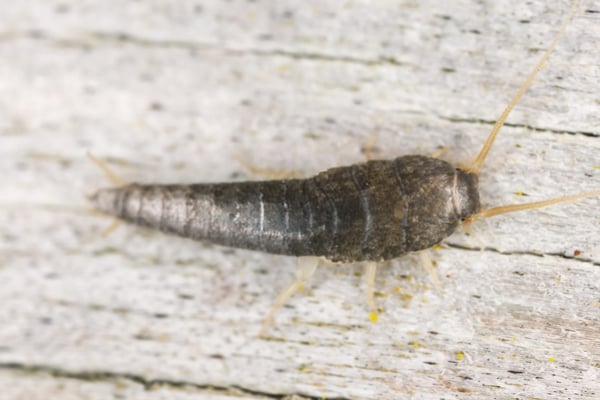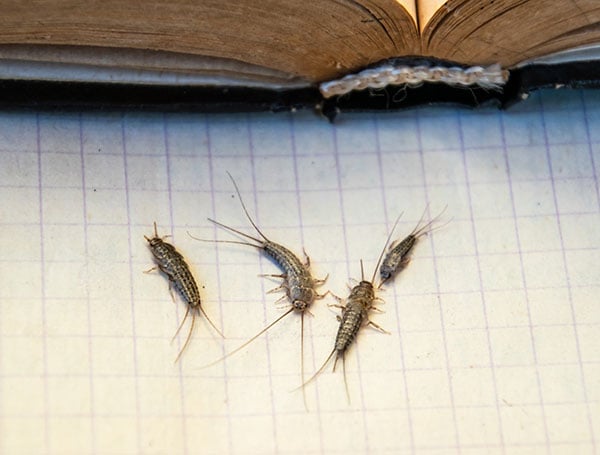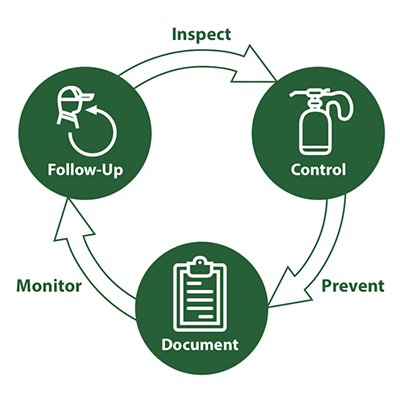Silverfish
Appearance And Behavior
The Silverfish is a teardrop or fish-shaped insect with silver-gray scales. This fungi, moisture, and decay pest has three long, bristle-like appendages protruding from the rear end of its body and a pair of long antennae.
Adult silverfish are wingless and possess a flattened body with a length of 1/2″ to 3/4″. Their elongated shape tapers from head to rear and is covered with fine, powdery scales. Immature silverfish are smaller than adults, but have a similar appearance. Their silver-gray scales appear after their third or fourth molt.
Silverfish feed almost exclusively on polysaccharide, which is a carbohydrate found in starches, glues, and paper products. They’re particularly fond of cardboard, books and book bindings, wallpaper, photographs, and fibers like cotton and flax. Silverfish are capable of roaming long distances in their search for food. Once they find a satisfactory food source, they generally remain close to it.

Silverfish spend a majority of their time hiding inside or among their food source. You may accidentally carry them onto your property while they’re hiding inside food sources like cardboard, books, or paper. Once inside, silverfish seek cracks and crevices to hide during the day. They find hiding places in nooks and crannies around living rooms, bedrooms, bathrooms, attics, basements, and garages. Older, damp commercial structures like offices, stores, and libraries are attractive targets for silverfish.
Silverfish Prevention

Property owners should reduce interior moisture and remove conditions that favor it. Promptly repair plumbing, roof, skylight, and window leaks. Use air conditioning and supplemental dehumidifiers to keep relative humidity below 50 or 60%. Reduce wetness on exterior walls by moving sprinklers and cleaning out clogged gutters and downspouts. Examine outdoor faucets and attached hoses for leaks. Consider moving irrigation to minimize foundational moisture.
Landscaping practices can also reduce harborage and moisture close to buildings. Trimming trees and shrubs away from roofing and exterior walls will help prevent moisture from accumulating close to the foundation. Keep timbers, stones, wood, and stacks of lumber away from the foundation of your building.
Silverfish Control Process
A Plunkett’s Pest Control technician will apply a residual liquid insecticide as an exterior barrier treatment around the structure’s foundation. We may strategically apply insecticide beneath wooden siding, shingles, and around structural junctures where silverfish enter and breed. Indoors, the technician will use bait and dust formulations in structural voids, especially around plumbing or electric and light fixtures. We may also apply bait and dust in attic areas if we can access them.
If you think you have a silverfish infestation in your home or business, you can give Plunkett’s a call anytime. No matter how entrenched the infestation, we have the tools and knowhow to wipe it out for good.

Silverfish Control With Plunkett's
At Plunkett’s, our goal is to help you quickly, conveniently, and in the most cost-effective way. We make every effort to be with you the same day or the very next day.
Learn More
There are all kinds of different humidity-loving pests. Click on any of the common fungi, moisture, and decay pests to learn more.






